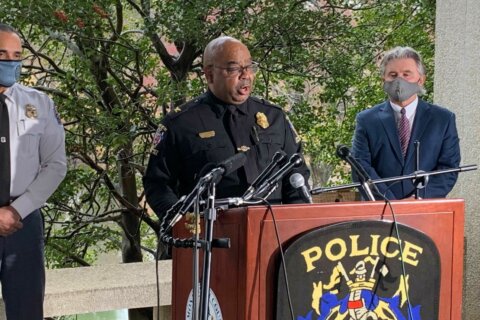Whether you’re involved in a car crash, see someone having a heart attack or have smoke filling your home, once you call 911, the first people to respond will most likely be the men and women at your nearest fire station.
I always knew being a firefighter or EMT is not an easy job, but recently, thanks to an opportunity provided by the Montgomery County Fire and Rescue Service, I was given a chance to see what the county’s bravest do on a daily basis.
The event was called Fire Ops 101, and its goal was to give members of the community, including the media and lawmakers a better understanding about what the job of a lifesaver entails.
“You can hear about what the fire department does; you can read about what the fire department does, but this was the experience opportunity,” Montgomery County Fire Chief Scott Goldstein said.
Once at the training facility in Gaithersburg, on a chair was a full firefighter’s uniform, from the boots to the helmet. On the day of the event, we’re blessed with temperatures in the low 70s, but it didn’t escape me that these get-ups also have to be worn in the middle of summer heat waves and inside buildings where fires burn far hotter.
Once suited up, I gathered with my group. Our first stop: A car lot behind the facility. This is where new recruits are trained on how to respond to a car accident.
Responding to a car crash
Standing in front of the minivan, the first lesson is to make sure your car is secure. To do this, wooden blocks were placed underneath the vehicle. Using a special tool, I removed the valve from one of the tires. This, as it was explained to us, puts the weight of the car on the blocks once all the tires deflate, making the car more stable.
Next, our attention turned to the hood. Underneath it, the battery had to be disconnected. This helps to prevent the air bags from deploying. Using another vehicle nearby, we saw what could happen if this step was missed. The air bags were activated on the car, and a loud boom erupted, as several air bags popped out — something that could clearly injure a first responder and those they are trying to help in a wrecked car.
“See why we disconnect that battery, to try and de-energize everything we can,” one of the firefighters explained.
Next, I was handed a tool with a tip that is no longer than 2 inches. I would soon learn this would be used to take out the entire back window of the van, so we can get to our pretend driver, which was a heavy training mannequin that was placed in the driver’s seat.
Wearing gloves and protective glasses, I formed a “V” with my hand and placed it near the edge of the glass at the frame, which helps to prevent my hand from going through the window when it shatters. I then thrust the tool into that “V,” and the window turned into tiny shards of glass.
Once the window was gone, we turned to the patient. My job was to get into the back seat to talk to and to secure the neck of our victim. While doing this, others in my group positioned a board that would be used to transfer the person from the car onto a stretcher.
With the board in place, one member of the team counted off, and we all helped move the dummy, which was the weight of an actual person, onto the board, all while trying to keep the neck stable.
The car we were doing the demonstration on was mostly intact, but you can see how having a mangled vehicle could really complicate getting a person out of the car.
The next demonstration I was sure would satisfy a childhood dream — using a hydraulic-extrication rescue tool; but I never called it that, instead it is known as the Jaws of Life. There were actually several versions of the tool, and I was told to pick up one of the earlier-made models.
As a firefighter helped me position next to a Volvo, my job was to remove the hinges from the driver-side door. But with the experience, there was a bit of disappointment. I didn’t see the “jaws” cut through the metal like butter, instead it stopped on the hinge.
It was explained to us that as vehicle manufacturing changes, new steels, such as boron steel, can’t always be cut by Jaws of Life-type devices made in the early 2000s or earlier.
“This is now outdated,” a firefighter said.
That’s why the fire department is working to switch to newer devices that can handle the task and have an added benefit — they are battery powered, which eliminates the need to connect to a hydraulic system. This means that there are fewer limitations as to where the tool can be used.
Fighting fires
In the D.C. region, there are many tall buildings, so fire departments are equipped with ladder trucks to get those firefighters to people in need of rescue or to better position them to put out a fire. My next task involved climbing a truck’s ladder — another childhood dream fulfilled — then it was on to the maze.
The maze is made to train firefighters how to crawl through smoke-filled homes and buildings when visibility is low. The quick lesson is to keep your shoulder against the wall. That was key, as I crawled up stairs, made my way through window frames and even slid down one section to finally arrive at the end. Thankfully, this demonstration had us in helmets, or otherwise I would have had several bumps on my noggin’ from my time inside.
This maze had a wall that would open, so you are never far away from an exit if need be. But in a real-life crawl through a building, it isn’t lost on you how dangerous making your way through a building to make a rescue can be, especially in full gear that includes a big oxygen tank on your back.
Montgomery County council member Andrew Friedson, who was in my group during the event, agreed.
“You realize how nerve-wracking and challenging it can be when you don’t know where you’re going, where you have no visibility, where you are crawling through an unfamiliar territory and don’t know what’s next,” Friedson said.
Finally, the best way to learn how to respond to a fire is to experience one. To give us the experience, we moved to MCFRS’ flashover simulator.
Inside what looks like a metal shipping container on wheels, the firefighters for a day entered in full gear, which included an oxygen tank. We danced our way inside with a goal of keeping the motion sensor on our suit from going off. Those sensors serve an important purpose: If a firefighter goes down, others will follow the sound in order to find them.
Once inside a fire was started. The doors controlled the amount of oxygen coming in. One thing you clearly noticed is how quickly the fire and smoke kick up with more oxygen. For me, it was a clear example of why you are told to close your bedroom door when you sleep — in case a fire happens during the night, it gives you more time with air to breathe.
Also an “I understand now” moment was seeing why staying close to the ground when escaping a fire is so important.
While on our knees, our helmets pushed into a thick black cloud of smoke, but we could see. Once you stood up, things were pitch black. Below that smoke, there was still some breathable air; but in the cloud, there was none.
After the fire, we went through the decontamination process. The importance of which is highlighted in this story, as fire departments try to bring down the skyrocketing number of cases of firefighters getting cancers connected to the job.
Medical Calls
The final experience was seeing what paramedics experience while on the job.
In our exercise, the part of an unconscious person was a mannequin Montgomery County Fire and Rescue Service uses during training.
My job was to do the chest compressions until the rest of my group could get a machine that does them for you in place.
As I kept the chest compression going with a metronome, Capt. Ty Dement gave us a better glimpse of what EMTs experience in these situations. He played the role of a family member, who in one case, is telling us first not to resuscitate the person, even though they do not have proof that is the person’s wishes. While working on the individual, we had to try and convey to the “family member” that we couldn’t stop.
When attempts to save the person stopped at 30 minutes, Dement then played the role of a family member who didn’t want us to stop. Even though what we just went through was just an exercise and someone’s life truly did not depend on our actions, it certainly opened my eyes to both the physical and emotional toll the job can take on these first responders.
I walk away from this event with an added appreciation for what the fire and other rescue workers do for the community on a daily basis.
The title of “bravest” is fitting for the work these men and women do for us on a daily basis. To them, I say simply: Thank you.








